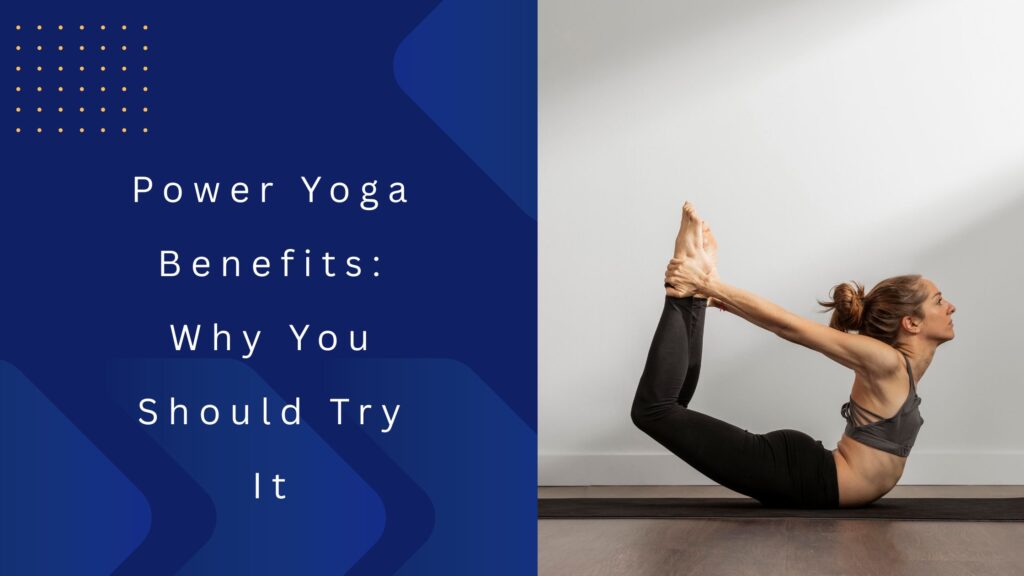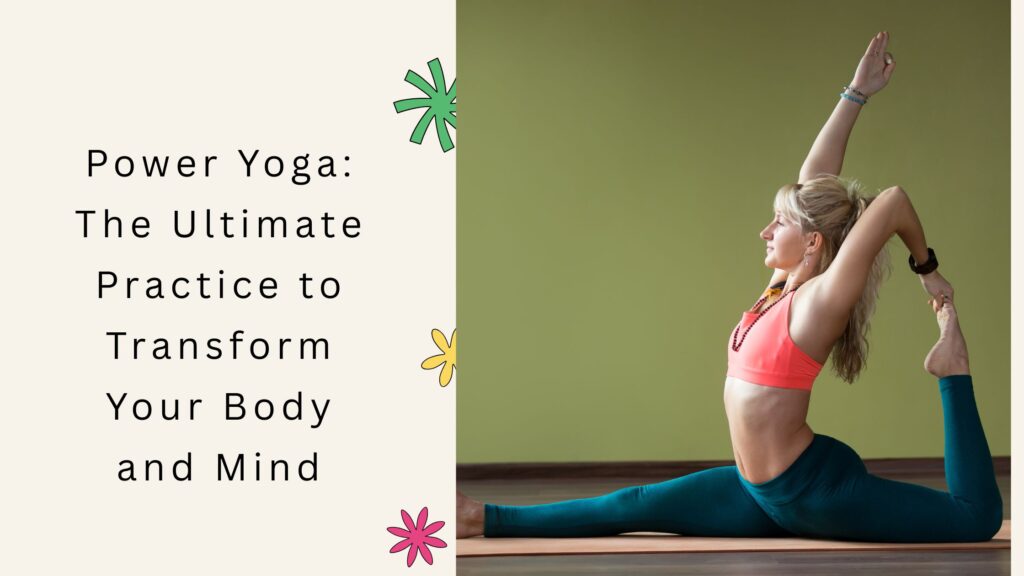Looking for a workout that sculpts your body, clears your mind, and energizes your spirit — all in one session? Power Yoga might just be your secret weapon. This dynamic and fast-paced yoga style has exploded in popularity across the globe for a good reason: it delivers results.
Whether you’re chasing weight loss, muscle tone, stress relief, or mental clarity, Power Yoga offers a complete transformation — physically, mentally, and emotionally. Let’s explore what makes this practice so powerful and why it could be the fitness breakthrough you’ve been looking for.
Power yoga is an energetic and physically demanding form of yoga that aims to develop strength, flexibility, and stamina through a series of flowing poses. This high-intensity practice also integrates breath control to enhance both physical performance and mental focus.
Table of Contents
What is Power Yoga?
At its core, Power Yoga is a modern, fitness-based style of yoga rooted in Ashtanga Yoga. But unlike the traditional sequences of Ashtanga, Power Yoga is more flexible, creative, and adaptable.
It’s characterized by:
- Continuous movement from one pose to another (often called a flow)
- Strength-building postures held longer than in traditional yoga
- Breath-synchronized movements, enhancing focus and endurance
- High intensity, making it closer to a cardio or strength-training session
Power Yoga = Strength + Flexibility + Sweat
If you’ve ever thought yoga was too slow or too passive, Power Yoga will challenge that belief. Think of it as yoga meeting athletic training — ideal for those who want to build strength, boost stamina, and break a sweat.
The Unique Power of Power Yoga
So, why is Power Yoga gaining so much attention in fitness circles and wellness communities? Here’s what sets it apart:
1. It’s a Full-Body Workout
From your core to your calves, every muscle is activated. Unlike static stretching or isolated gym routines, Power Yoga recruits multiple muscle groups simultaneously, giving you a functional and efficient workout.
2. No Two Sessions Are the Same
Because Power Yoga doesn’t follow a fixed sequence, instructors (or you, if you’re doing it at home) can modify flows based on goals — strength, balance, detox, flexibility, or mindfulness. This creative freedom keeps your mind engaged and your body constantly adapting.
3. It’s Just As Much About the Mind
Yes, Power Yoga makes you sweat. But it also sharpens your focus, disciplines your breath, and elevates your mental resilience. It’s a moving meditation — perfect for those seeking stress relief and emotional balance.
Power Yoga Benefits: Why You Should Try It
The benefits of Power Yoga are both immediate and long-term. Here’s how it can positively impact your life:
Physical Benefits
- Increases lean muscle mass and tones the body
- Improves flexibility and posture
- Supports weight loss through high caloric burn
- Boosts cardiovascular health
- Enhances stamina and endurance
Mental & Emotional Benefits
- Reduces anxiety and tension through conscious breathing
- Builds mental clarity and emotional resilience
- Encourages mindfulness and presence
- Boosts self-esteem and confidence as strength improves
Read More: Transform Your Mind and Body: What to Expect in a Yoga Class
Read More: Surya Namaskar: The Ancient Yogic Ritual to Transform Your Body and Mind

Power Yoga for Weight Loss
If you’re wondering, “Can Power Yoga help with weight loss?” — absolutely. While it may not be as calorie-burning as HIIT, Power Yoga for weight loss is incredibly effective because it builds lean muscle and increases metabolism. Plus, it keeps you consistent due to its engaging nature.
Key Elements of a Power Yoga Session
Power Yoga sessions usually follow this structure:
1. Warm-Up with Sun Salutations (Surya Namaskar)
These dynamic sequences warm up your joints, muscles, and cardiovascular system while connecting breath to movement — a core principle of Power Yoga.
2. Strength & Flow Sequences
Expect a series of:
- Standing poses like Warrior II, Chair Pose, and Crescent Lunge
- Balancing poses like Tree Pose and Half Moon
- Core-focused transitions and planks
- Dynamic flows linking movements with breath
3. Breath Control (Ujjayi Pranayama)
The use of Ujjayi breathing (a controlled, whispery breath) helps regulate energy and maintain focus throughout your practice.
4. Cool Down and Relaxation
Stretching, hip-openers, and Savasana (corpse pose) round out the session to calm your nervous system and integrate the benefits.
Beginner-Friendly Power Yoga Sequence (Try This Today)
Want to get a taste of Power Yoga at home? Here’s a simple 20–30 minute flow:
➤ Warm-Up:
- 2 rounds of Sun Salutation A
- 2 rounds of Sun Salutation B
➤ Main Flow:
- Chair Pose – 5 breaths
- Plank to Chaturanga – repeat 3x
- Warrior II → Extended Side Angle → Reverse Warrior – 5 breaths each
- Boat Pose (Navasana) – 3 rounds of 30 seconds
- Bridge Pose – 2 rounds
➤ Cool Down:
- Seated Forward Fold
- Supine Twist
- Savasana – 3-5 minutes
Pro tip: Always move with your breath and keep your core engaged!
Power Yoga vs. Other Styles of Yoga
Wondering how Power Yoga compares to other forms of yoga? Here’s a breakdown:
| Style | Intensity | Structure | Focus Area |
| Power Yoga | High | Flexible & creative | Strength + Cardio + Focus |
| Vinyasa Yoga | Medium | Flow-based | Breath + Flexibility |
| Hatha Yoga | Low | Static poses | Alignment + Relaxation |
| Ashtanga Yoga | High | Fixed sequence | Discipline + Progression |
Power Yoga offers the flexibility of Vinyasa, the discipline of Ashtanga, and the intensity of a gym workout — all in one.
How to Get Started with Power Yoga
What You’ll Need:
- A good-quality non-slip yoga mat
- Yoga blocks or straps (for modifications)
- Towel (you’ll sweat!)
- Water bottle
- Optional: resistance bands or ankle weights for advanced practice
Tips for Beginners:
- Start slow and focus on form, not speed
- Modify poses with blocks or knee support
- Don’t compare your progress — consistency is key
- Practice 2–3 times a week to build rhythm
Home vs. Studio: What’s Best?
Practicing Power Yoga at Home:
- Convenience and flexibility
- Access to YouTube, apps, or online subscriptions
- Requires self-discipline and a quiet space
Practicing in a Studio:
- Guided instruction and real-time feedback
- Motivational group energy
- Helps correct posture and avoid injuries
Both options are great — choose what aligns with your lifestyle.
Final Thoughts: Why You Should Start Power Yoga Today
Power Yoga is more than a workout — it’s a lifestyle upgrade. Whether you’re looking to build a strong, toned body, shed stress, or simply feel more energized and alive, Power Yoga can take you there.
Unlike rigid gym routines, Power Yoga offers variety, creativity, and holistic benefits. It meets you where you are and helps you evolve — mentally, physically, and spiritually.
So, why wait?
Roll out your mat. Take a deep breath. Step into your power.
Power Yoga is waiting for you — and your best self is just one flow away.
Power Yoga FAQs:
Q. Can I lose weight with Power Yoga?
Ans: Yes! The intense flows burn calories, tone muscle, and build lean mass, all of which support fat loss.
Q. Is Power Yoga suitable for beginners?
Ans: Absolutely. Many beginner-friendly classes are available. Start slow and listen to your body.
Q. How often should I practice Power Yoga?
Ans: For results, aim for 3–5 sessions a week. Mix in rest or gentle yoga days for recovery.
Q. Do I need to be flexible to do Power Yoga?
Ans: Not at all. Flexibility improves with practice. Strength and breath are more important starting out.
Q. What is the difference between yoga and power yoga?
Ans: Yoga encompasses a wide range of styles—some prioritize physical movement, while others center on meditation and mindfulness. Power yoga, however, is a distinct and more vigorous form that places a strong emphasis on physical fitness.
Q. Can beginners do power yoga?
Ans: Power yoga may appear intimidating to those new to fitness, but it provides a powerful combination of strength, flexibility, and mindfulness that can be highly beneficial for beginners. Its energetic flow helps build endurance while enhancing overall well-being.
Q. Can power yoga reduce belly fat?
Ans: Power yoga is a vigorous, fast-paced form of yoga that burns more calories than traditional styles. It blends strength, flexibility, and cardio to effectively promote weight loss and target belly fat. The constant flow and demanding poses elevate heart rate and boost metabolism, helping the body burn fat more efficiently.
Q. What is another name for power yoga?
Ans: Power Yoga refers to various dynamic vinyasa-style yoga practices that emerged in the United States during the 1990s. These include styles influenced by Ashtanga Vinyasa Yoga, developed by teachers like Beryl Bender Birch, Bryan Kest, and Larry Schultz, as well as versions inspired by Bikram Yoga, such as the approach created by Baron Baptiste.
Q. Is power yoga difficult?
Ans: Since both Ashtanga and power yoga are practiced in a more intense and dynamic way, they demand greater patience, discipline, and a solid foundation of physical fitness. You can expect to put in serious effort and break a sweat.
Declaration Note:
We use third-party videos and images on https://yogavidhi.com/ for educational and illustrative purposes. All rights belong to their respective owners. No copyright infringement is intended.



